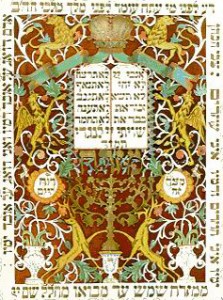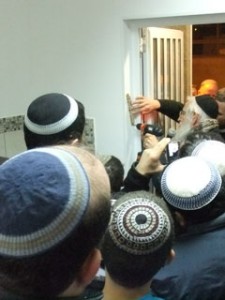A number of Jewish symbols are commonly found in a Jewish home.

MEZUZAH
‘Mezuzah’ is the name given to the parchment scroll that is attached to the doorposts of Jewish homes. It is nailed to the right hand doorpost as one enters the room. The word ‘mezuzah’ itself means doorpost, but the name has come to refer instead to the scroll. Its container can be made from metal, wood or ceramic and it identifies a home as being Jewish. The commandment of having a mezuzah on our doorpost is to be observed purely from the love of God. It is not meant to be a good luck charm to ward off evil spirits.
For more detail, see our Mezuzah page.
CANDLESTICKS
Candlesticks can be found in every Jewish home, as they are used on a regular basis to usher in the Shabbat and most Jewish festivals. Many candlesticks are made of silver, or silver plate, but they can be made of any material, such as glass, brass, bronze and so on. Candelabra are almost as common as individual pairs or sets of candlesticks.
Many young Jewish girls have their own candlesticks which they use for lighting Shabbat and festival candles. Candlesticks are a popular and sentimental Bat Miztvah and/or wedding present for Jewish women. Many women take great pride and pleasure in using candlesticks that have been handed down the generations from their mothers, grandmothers and beyond.
For more detail, see our Candlesticks page.
CHANUKIAH
 The chanukiah, or eight-branched candelabra is a well-known symbol of the Jewish home. The chanukiah is used during the festival of Chanukah to commemorate the miracle of the oil that lasted eight days when Judah Maccabee rededicated the Temple his army had liberated from the Greeks.
The chanukiah, or eight-branched candelabra is a well-known symbol of the Jewish home. The chanukiah is used during the festival of Chanukah to commemorate the miracle of the oil that lasted eight days when Judah Maccabee rededicated the Temple his army had liberated from the Greeks.
Jewish children often make or at least own their own chanukiot, which they use to light the candles of the eight nights of the festival.
For details of how to light a chanukiah, please see our Chanukiah page.

MIZRACH
The word mizrachi means ‘east’ and it refers to a decorative item traditionally placed in Jewish homes to indicate the correct direction in which to face when praying. When praying, Jews should face towards Israel, and as Israel lies east of Europe where many Jews lived during the middle ages, they would face east when praying. Over time, a custom developed of having an item, called a mizrach, to indicate in which direction east was.
Many modern homes still have a mizrach, but, depending on the location of the home, it may not necessarily be found facing east. For example, Israel lies north-west of Australia, so in Australia that is the correct direction to face when praying. In spite of this, it is still known by its traditional name of mizrach and, in fact, the design will always incorporate the word mizrach written in Hebrew lettering. It most frequently takes the form of a picture or plaque placed on a wall.
SHIVITI
The shiviti is similar in appearance to the mizrach and is usually found hanging in the synagogue. However, it is increasingly common to find this wall hanging displayed in homes, providing a conscious reminder of God’s presence.
The word ‘shiviti’ is derived from Psalms 16:18, and translates as ‘I am ever aware of the Lord’s presence.’ Like the mezuzah and tefillin, this display serves to remind householders of God’s omnipresence. A shivititraditionally has a central depiction of God’s four-letter Name, surrounded by other relevant excerpts decorating the verse.
CHANUKAT BAYIT – JEWISH HOUSEWARMING
Chanukat Bayit translates as ‘dedicating a home’, and is a practice referred to in a portion of the Bible, Deuteronomy 20:5.
In Deuteronomy one is commanded to dedicate a new home as an official endorsement of its new place and purpose. “Is there anyone who has built a new house but has not dedicated it? Let him go back to his home, lest he die in battle and another dedicate it.” (20:5).
It has become customary to dedicate a dwelling upon moving in, and some make the Chanukat Bayit an occasion to invite friends and relatives to their new home.
At a Chanukat Bayit an appropriate blessing is recited and a mezuzah is affixed to the house’s front and other doors. A mezuzah is a small box containing portions of biblical text.
Although there is no set procedure for the Chanukat Bayit, a suggestion would be:
1. the recital of the appropriate prayers
2. the affixing of the mezuzah
3. the reading of additional relevant material

Additional material and songs, which could be used to enhance the dedication are Psalm 15, which encapsulates the Jewish ideal of human conduct and Psalm 119, where a single acrostic of the word ‘brachah’, meaning ‘blessing’, is formed.
Upon first moving in to your new house, it is customary to leave a certain space or wall free of decoration and furnishing as a remembrance of the destruction of the Temple (zecher lachurban).
Another suggestion to emphasize the Chanukat Bayit is to have a ‘God’s corner’ as described by Zalman Schachter, which is exclusively used for prayer and meditation.
It has also been known for Jewish people to use bread, salt and candles to initiate their new home. The bread represents the hope that there will always be enough food; the candles are a symbol of light and joy; and the salt is a reminder of the Temple sacrifices and tears shed.
Chanukat Bayit can assist in the process of settling into a new space. By dedicating a house, its new Jewish residents help make it their home.


